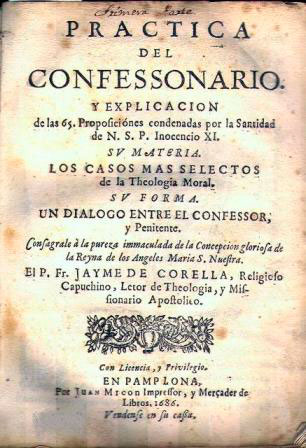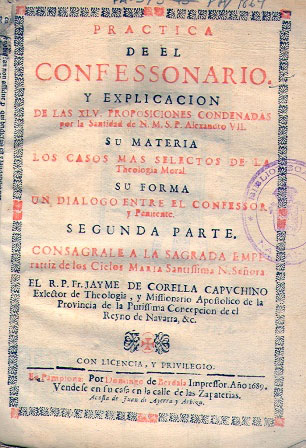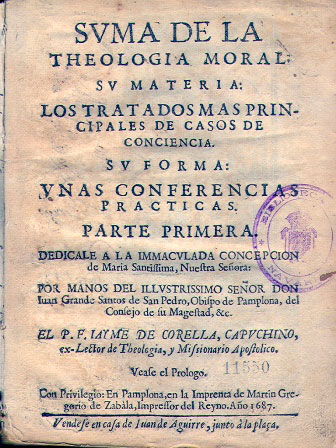BRINGING HERITAGE CLOSER. CORELLA
24 August 2010
Writers and publicists in Baroque Corella
Javier Itúrbide Díaz. UNED of Tudela
The Capuchin Jaime de Corella (1657-1699) represents the Spanish Baroque religious dedicated to preaching and at the same time to the essay of moral works. He was surprisingly intense in his pastoral activity, preaching missions in Navarre, Castile and Aragon, which gave him enormous prestige to the point of earning him the title degree scroll de Predicador de Su Majestad (His Majesty's Preacher).
Corella, his homeland, had the opportunity to listen to him during Lent and to promote the edition of the sermon that Juan Micón printed in Pamplona in 1687. Jaime de Corella deploys all the elements of the disproportionate sacred oratory of the Baroque period, in which the preacher takes centre stage and displays infinite erudition, providing a cataract of quotations from religious and secular authors, in which Latin and Spanish are intermingled to form an unintelligible speech , where the message, the moralising intention, is difficult to glimpse through the barrage of rhetorical devices.
In 1695, four years before his death, which came at the early age of 42, Jaime de Corella had the opportunity to preach again to his fellow citizens on the occasion of the feast of the Virgin of Araceli, a sacred image found in 1674 at Shrine of Our Lady of Fair Love in Santa Lucía, which he chronicled in his portentous finding. The sermon was printed in Pamplona by the typographers Lázaro González Asarta and Guillermo Francisco, whose activity was ephemeral, as only a couple of titles are known to have appeared between 1695 and 1696.
Jaime de Corella personifies the taste and excesses of Baroque sacred oratory, but he is not the only one among his fellow citizens, as mention should also be made of the Jesuit Carlos José Miñano and the Mercedarian Francisco Sesma y Sierra. The sermons of these religious were printed in and outside Navarre between 1699 and 1738.
The fame that Jaime de Corella achieved in the pulpit was consolidated with the dazzling success of his books, to the point of constituting a phenomenon publishing house in Baroque Spain. In 1686, the internship del Confesionario appeared, printed in Pamplona, by Juan Micón, to whom the author had ceded the publishing privilege in exchange for a hundred books. The print run, which was probably 1,500 copies, was sold out in a few months, making a second edition necessary the following year, which was once again printed by Juan Micón in exchange for seventy copies of the submission . The fame of the work spread rapidly, with editions multiplying in Zaragoza, Burgos, Valencia, Barcelona and Madrid. Sometimes they were produced simultaneously, as happened, for example, in 1689, when it was printed in Burgos, Valencia and Barcelona.
The author's fulminating success, which reached him when he was about to turn thirty, can be explained, among other reasons, by offering a synthesis of "very classical theologians" - as he warns the reader - while his participation was limited to that of a mere transcriber: "I have tried not to invent new doctrines, because in novelty there are many risks".

Cover of the first edition of the "Practica del Confesonario" by Jaime de Corella. Pamplona, 1686.

Cover of the first edition of the "internship del Confesionario. Second Part" by Jaime de Corella. Pamplona, 1689.
Around the same time, the bishop of Pamplona, Juan Grande Santos de San Pedro, urged him to bring out the Summa de Teología Moral, a work that was in demand and which his intense pastoral activity did not allow him to finish. He complains that he has only had two months of quiet time to finish it, even though in that time he has had to attend to matters that cannot be postponed. The Summa was printed in the capital of Navarre in 1687, in the workshop of Martín Gregorio de Zabala, with the bookseller Juan de Aguirre, to whom the author had ceded the rights, acting as publisher . The frenetic activity publishing house of the Corellan Capuchin is confirmed by the appearance, in the same year in Pamplona's printing presses, of the aforementioned Suma de Teología Moral, the second edition of the internship del Confesionario and the Lenten sermon delivered in his native city.
Success also accompanied the appearance of the Summa de Teología Moral, largely because it was endorsed by the bishop of Pamplona, who recommended it to the diocesan priests. The author, by way of an advertisement, announces on the title page that the text has been adapted to the methodology of the "practical moral conferences", a system of permanent training which the clergy are obliged to follow through fortnightly meetings. The author's creative impetus encouraged him to announce the appearance of two new volumes, which would finally see the light of day in 1693 and 1700.
Jaime de Corella's publishing projects did not end here, as he had made a commitment to the readers of the internship del confesionario that if God and the Virgin "give me health, and the exercise of the missions allows me some free time, I will soon publish the second part of this work". And it was not long in coming, as it was published in 1689, in the Pamplona workshop of Domingo Berdala, at position by Juan de Ayerra, secretary of the Royal committee , with whom he negotiated the transfer of the copyright. The second edition, submission, was a success and sold out in a few months, requiring the preparation of a new edition, which would be published the following year in the same workshop and with the same title publisher.
It is significant that, in the field of Moral Theology, Navarrese authors exercised an indisputable hegemony during the Ancien Régime: in the Renaissance it was unquestionably Martín Azpilcueta with his guide de confesores, published in Coimbra in 1522; as we have just explained, in the Baroque period it passed into the hands of Jaime de Corella, mainly with the internship del Confesionario, and from 1706, when the Age of Enlightenment began, it was the Dominican Francisco Larraga, whose Prontuario de Teología Moral would become an essential guide until well into the 19th century.

Cover of the first edition of the "Suma de la Teología Moral" by Jaime de Corella. Pamplona, 1687.
PROGRAM
Tuesday, 24th August
Milestones in the History of Corella
D. Esteban Orta Rubio. Society of Historical Studies of Navarre
Writers and publicists of Baroque Corella
Mr. Javier Itúrbide Díaz. Uned of Tudela
Corella in the culture and art of the Baroque period
D. Ricardo Fernández Gracia. Chair of Heritage and Art of Navarre
Wednesday, 25th August
The hidden Corella. Behind the lattices of the city's enclosures
D. Ricardo Fernández Gracia. Chair of Navarrese Heritage and Art
The sumptuary arts: at the service of the splendour of worship and the Liturgy
D. Ignacio Miguéliz Valcarlos. Chair of Navarrese Heritage and Art
The festive calendar
D. Francisco J. Alfaro Pérez. University of Zaragoza
visit to the church of San Miguel
visit to the tunnels
Thursday, 26th August
A look at architecture and the arts in Corella in the 19th and 20th centuries
José Javier Azanza López. Chair of Navarrese Heritage and Art
The image of the Rosary and Saint Michael in the arts
Ms. Mª Gabriela Torres Olleta. GRISO. University of Navarra
Corella, conventual and palatial city: visit guided tour
Ms. Pilar Andueza Unanua. Chair of Navarrese Heritage and Art
Closing

